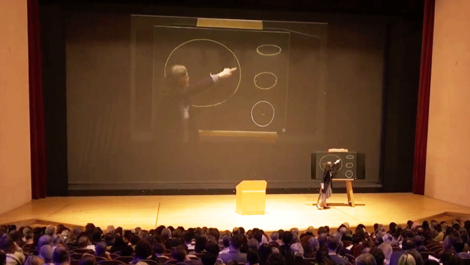Why does the child trust her or his teacher? Because the teacher turns towards both the child and the world – recognising and affirming both. This double attention was the basis of Rudolf Steiner’s pedagogy. It is the prerequisite for the relationship between child and teacher, out of which learning about the world and participation in the world can arise in the first place. An abridged version of the contribution by Constanza Kaliks in «Das Goetheanum».
«More human, more in the world»: This was a guiding motif in Josep Maria Esquirol's opening lecture at the World Teachers' Conference 2023 at the Goetheanum. It echoed what lived throughout the gathering of educators and teachers. The child is at the centre and the world is at the centre – and both live simultaneously in the consciousness of the educator.
They are two centres that together form the two foci of an ellipse of attention. Pedagogical attention resembles a movement on this ellipse: closer by turn to the child, then closer to natural phenomena, to a story, closer to a mathematical equation, to a discovery, closer to the richness of world phenomena. Teachers can develop a sensorium for such proximity and for holding a perceptive, attentive distance. It is a , prescient, yet tentative seeing that is turned towards the child, towards the nascent human being, towards the new citizen of the world who wants to be a fellow citizen of a common world.
Cognition becomes active participation in the becoming of the world
Thus, learning becomes learning for a common world. We know ourselves to be interdependent, reciprocal, and unique – with all our fellows, who are also unique. Knowledge of a shared world and responsibility for it form the fertile ground for pedagogy, as well as for society. Educational questions are social questions.
Rudolf Steiner formulated this increasingly visible reality as early as the first decades of the 20th century. Over the Christmas and New Year period of 1922/23 Steiner gave the course. The emergence of natural science in world history and its development since then. This course was not specifically addressed to teachers. But in it, Steiner points to a crucial turning point for teachers: the century in which modern natural science is born.
It is the century that lies between Nicolaus Cusanus' Docta ignorantia in 1440 and the publication of De revolutionibus orbium coelestium by Nicolaus Copernicus in 1543. The developments that followed these moments of birth brought people both «renunciation and fertilisation for the life of the soul».1 Much, indeed most, of what we know comes from a perspective born in modernity; the image of the human being and the universe that underlies natural science.
From the 15th century onwards, there is an increasing awareness that the earth as an object belongs to humanity. In modern times, the world is measured and time is ordered. The developments of natural science enable humankind to wield power and satisfy an urge for possession, up to and including domination and, beyond that, systematic destruction. 400 years later, the danger that arises from this power for humanity and world becomes clear and existential.
In the 20th century, another form of the relationship between the world and human beings emerges. It is a humanity without power, a growing awareness of the necessity to take up responsibility for the living conditions of the earth and of humanity. The philosopher Hans Jonas writes that dependence is not an expression of deprivation or powerlessness, but of development, of complexity and differentiation.2 It is a matter of being alert and attentive to the knowledge of the endangered humanity of the human being, which, as a gift that has been granted, must be protected and nurtured.
Rudolf Steiner developed anthroposophical spiritual science for this new beginning. «More human, more in the world» at the turn of the 20th century meant something different from «more in the world» at the moment when natural science emerged. It is a cognition without power, but which does not stand powerless in the face of world events. Knowledge becomes an active participation in the becoming of the world, in the becoming of the human being. Rudolf Steiner founded the School of Spiritual Science for this search for knowledge, its development, its methods and its effectiveness.
We need the other one
The most important thing is a study of the human being, an image of the human being as the basis for pedagogy: not as a normative measure, but as an orientation for a «cognitive recognition», for learning to perceive the uniqueness of the real child, the real young person. The perspective of an I is crucial, and for this the other and the world are constitutive, indispensable experiences. «The I is real through its participation in reality. It becomes all the more real the fuller the participation is.»3
Learning needs the other. For the child, for the growing young person, learning is a process that unfolds in the immediate relationship to another person. It takes place in the face of the other. It needs someone who sees what I see, to whom I can show what I perceive, who shows me what I may see, what I may know, and recognize. The beauty of the world is revealed in sharing.
Learning is based on relationship. This changes, develops, and is in motion. Educators are given the task by society to take responsibility for the possibilities of relationship. They have to mediate the relationship, make it possible and promote it. To do this, they themselves must become «more in the world», more human. (...)
Constanza Kaliks
Literature
1: Cf. Steiner, Rudolf GA 326. the emergence of natural science in world history and its development since then. 4th ed. 2017. Dornach: Rudolf Steiner Verlag, p. 21f.
2: Cf. Hans Jonas. Teaching letters to Lore Jonas. In: Hans Jonas. Memoirs. Frankfurt am Main: Suhrkamp, 2005, p. 359.
3: Martin Buber. I and Thou. In: The Dialogical Principle. Gütersloh: Gütersloher Verlagshaus, 2014, p. 66.

